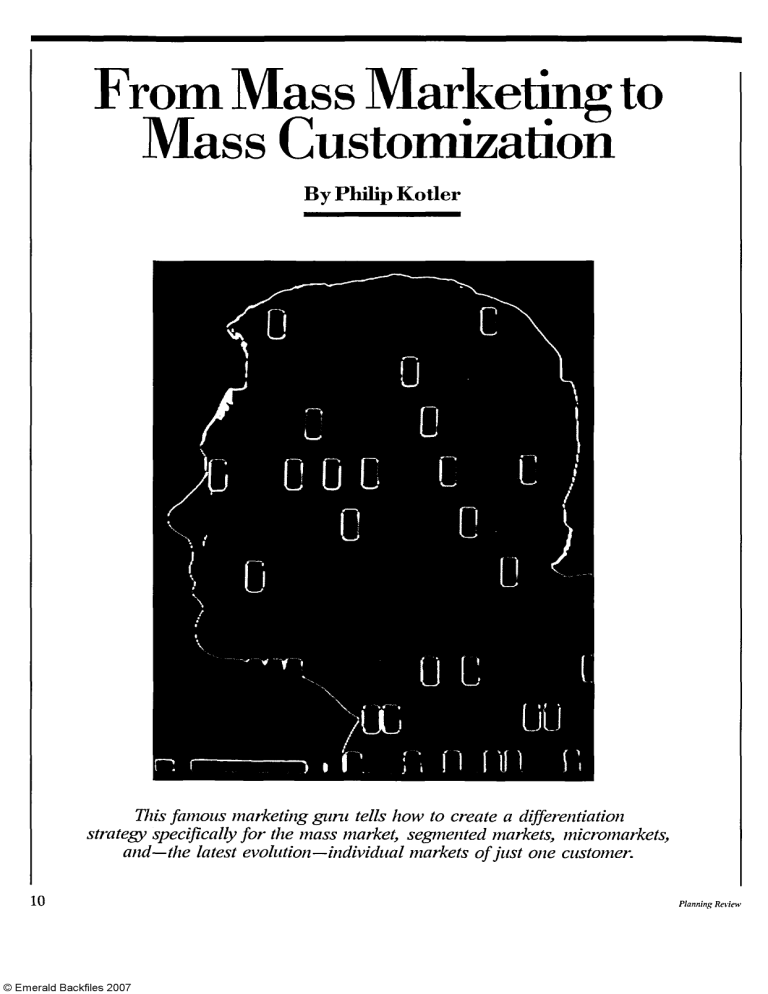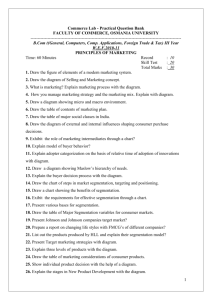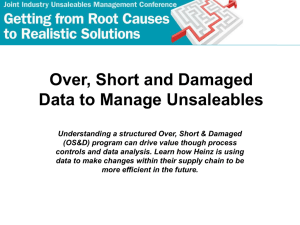From Mass Marketing to Mass Customization

From Mass Marketing to
Mass Customization
By Philip Kotler
This famous marketing guru tells how to create a differentiation strategy specifically for the mass market, segmented markets, micromarkets, and—the latest evolution—individual markets of just one customer.
10 Planning Review
T |oday, sophisticated segmentation is a critical marketing skill, but many practitioners are confused about how to integrate segmentation and planning.
The term "market segmentation" was introduced into the marketing literature in 1956 by Wendell R. Smith in an article entitled, "Product Differentiation and Market
Segmentation: Alternative Strategies." Smith used the phrase to label a strategy, just as product differentiation would be a strategy. But it really isn't a strategy—it's an analytical act that precedes the development of strategy.
One way to understand this is to learn the four "Ps" of strategic marketing. Everyone knows about the four
"Ps" of tactical marketing: Product, Price, Place, and
Promotion. But you don't really get down to tactical brass tacks until you perform the strategic marketing task. So let me introduce you to what I call the four "Ps" of strategic marketing, and show you the role that segmentation plays.
The Four Ps of Strategic Marketing
The first step we always need to take when approaching the marketplace is to analyze it. Although we tend to call this "market research," my term for this process is "Probing."
The second step is segmentation, or "Partitioning" the market. This commences when you begin to notice that clusters of your customers want different things. So you begin to treat each cluster separately.
The third step is to target the clusters where you feel you have a preeminent position. I call this
"Prioritizing"—ranking the segments you want to focus on because you have a potentially superior advantage for satisfying them.
The fourth step is "Positioning"—pinpointing the competitive options in each segment that you're going to target.
To reiterate, the four steps of market segmentation are:
Probing, Partitioning, Prioritizing, and Positioning.
Once you finish developing the four " P s " of strategic marketing, as well as carrying out the four " P s " of tactical marketing, your job will be much easier. As Peter
Drucker reminded us several years ago: "The aim of marketing is to make selling unnecessary." You want to do such a good job of figuring out what your target market wants that your product sells itself. For example, the Mazda RX-7 and the new Lincoln Continental hit the
Philip Kotler, professor of marketing in the Kellogg Graduate School of Management at Northwestern University, is a one-man marketing literature industry. His book, The New
Competition (co-authored with Planning Review editor Liam
Fahey), is mentioned respectfully in the Books section. mark so well that they went on back order. (Of course, back ordering isn't a particularly good situation—it means you didn't raise the price high enough.)
Four Levels of Market Segmentation
Next, let's consider the four levels of segmentation, which I will call:
■ Dealing with the mass market.
■ Dealing with segmented markets.
■ Dealing with micromarkets (as distinct from segmented markets).
■ Dealing with individual markets, down to the individual customer as a segment.
My first introduction to the mass market concept occurred in Japan some years ago. I noticed that the marketing researchers were taking very small samples of the consumers when measuring their attitude toward a new product. A market researcher would take a new product to just one or two Japanese households and ask,
"How do you like it?" This didn't seem right to me.
"How can you generalize from the sample of one?" I complained. And the answer was, "We Japanese are homogeneous. We're all alike. If this family likes the product, everyone will like the product." (While I doubt that this was ever true, nowadays the Japanese market has certainly become too diverse to approach in this simplistic way.)
Mass marketing in the U.S. used to aim products at the typical American family, which consisted of a working husband, a homemaker wife, and two children.
But today, this ''archetypal" American family makes up just 7 percent of the population.
I remember talking to Professor Paul Green at the
Wharton School about an assignment he'd received from a food company to design the optimum pizza for the
American family. "Optimum for whom?" I asked. No one brand or formulation can satisfy this mythical market. It's become an elusive and futile target, especially when competitors are using a niche strategy.
A company chasing the "mass market" loses it. It's a paradox, but that's what my research has found.
In discussions of market segmentation we often hear about manufacturers aiming at women ages 18 to 34, with household incomes over $20,000. In my opinion, the internal heterogeneity of that group makes targeting it en masse impossible. Women between 18 and 34 will read quite different magazines, have different lifestyles, different ambitions, and quite different brand preferences.
Another example of an overly broad market slice would be the luxury car market, consisting of highincome households buying cars. It is true that if an auto
September/October 1989 1 1
company decides to go after the luxury car market, it will have less competition than if it went after the bigger market that buys cars at an average price. But in the luxury car market there's quite a difference between making and selling a Rolls, a Jaguar, a Ferrari, and a
Porsche. Researching and focusing on the microsegmentation of that market is crucial.
And yet, there are times when broad segmenting works. Let's take industry focusing, for example. The
AT&Ts and the IBMs are setting up sales branches that are specialized by industry. However, this approach creates a dilemma of its own. Suppose your computer firm has a branch located in a city where there are many banks but only one manufacturing plant. It's highly likely that everyone in your branch office will be a bank specialist. They'll be expert on the competitive problems of bankers, and will try to sell these customers computers that will add value to the banking business and enhance their ability to outdistance the competition.
But what about that manufacturing plant? Who on your team is capable of handling this customer in a town with a lot of banks? Should you send in one of your specialized banking salespersons to "talk shop?" No.
What you do is fly in a manufacturing specialist from another branch who can establish a relationship that will convert the prospect into a customer. To be effective in today's market, your salespeople must have an intimate knowledge of their customers' businesses; they must specialize by industry.
Ketchup for Jail Birds
Heinz ketchup's success in the institutional market is one of my favorite illustrations of specializing by industry. Years ago a Heinz product manager of ketchup would handle grocery sales, restaurant sales, sales to hospitals, and colleges. More recently, Heinz has organized itself by end-use markets, designating managers to devise sales strategies for ketchup and mustard by industry.
For example, let's take Heinz' approach in selling to prisons, which is both a growth market and a captive market—if you'll forgive the pun. Can you imagine a sales rep from Heinz walking in with a bottle of this leading brand ketchup, and pitching to the purchasing agent: "Your prisoners deserve the best. And our premium product will do the best job of covering up the lousy food you serve." (By the way, ketchup is an important purchasing decision on the part of the catering group in the prison; they do, indeed, need something that will enhance, or at least disguise, the food. ) Well, of course the warden and the purchasing people would say,
"We can't spend a dollar a bottle for ketchup!"
At this point, either Heinz is out of that end-use market, or it employs a specialist—a prison market manager—to reformulate the product and to help the company respond appropriately to the customer's requirements. When Heinz did this, they ended up using their second-grade tomatoes to formulate a lower cost product for prisons. And they also packaged the product in barrels with spigots, instead of the potentially lethal glass bottles.
Heinz also wanted to make sure that the salespeople dealing with prisons knew the industry well, so it recruited wardens who wanted a new career. The wardens, of course, network with other wardens. They can talk shop and really win preference for the company's product. As Heinz discovered, industry specialization and focusing gives a strong competitive advantage.
Zip C o d e Micromarketing
Next let's study microsegmentation, or micromarket ing—I'll give you two illustrations, one consumer, and one industrial. The most exciting recent development in consumer marketing is the geo-demographic analysis system. (The Prism system by Claritas, or the Cluster
Plus system by Donnelley, are commercial examples). If you want to learn more about these systems, read the new book called The Clustering of America by Michael
Weiss.
The developer of the Prism system, Jonathan Robbin, was a computer expert, and also an entrepreneur.
Working with census data, he identified 40 socioeconomic groups that make up the lifestyles of the
United States. He characterized each by a sobriquet, such as the "fur and station wagon c r o w d . " Robbin's classification is based on the assumption that people in a given area are relatively alike, and that this alikeness shows itself through similar media habits and brand choices. Using his 40 lifestyle groups, you can zero in on zip code areas, or even city blocks, where you'll find the best prospects for your products.
For instance, zip 85254 in northeast Phoenix, Arizona, is a "fur and station wagon" neighborhood. According to this theory, you can predict that the members of this group probably belong to a country club, drink vermouth, read Gourmet magazine, and vote
Republican. In addition, Robbin believes this zip has much more in common with geographically distant
Glenview, Illinois, than it does with its own neighboring zips in Phoenix. "Old Yankee Rose" is another category he's christened (zip 02151 in Revere Beach,
Massachusetts). Robbins says it's characterized by beer drinking, fraternal clubs, and voting the Democratic ticket.
Now if you're a book publisher, it would be useful to identify which of the 40 lifestyle groups are intense book readers—or book buyers. (A normal group is at 100
12 Planning Review
percent, if you find that some group is 150 percent, this means it buys 50 percent more of the product than the normal group.) Robbin's lifestyle groups called, "money and brains," "the young influentials," the "fur and station wagon crowd," and "young suburbia," are the four most intense book-buying groups. When you choose the site for a new bookstore or when you're looking for direct mail opportunities to sell memberships in Bookof-the-Month clubs, you can find out the zip c o d e s even the blocks—which consist of a high percentage of those lifestyle groups in the population.
You can segment the market even further. When selling by mail, you can make the reasonable assumption that the "fur and station wagon crowd" will be good customers for gardening books. You could also assume that people in the "money and brains" group would be an excellent target audience for business books. customer. Stanley Davis, whose article in Planning
Review (March/April 1989) introduced his book, Future
Perfect, coined the seeming oxymoron, " m a s s c u s t o m i z a t i o n . " Davis' idea is that the new technologies—computers, telecommunications, robot factories, the flexible factory, the Fax machine, and such high-speed carriers as Federal Express—now make it possible for marketers to customize their offerings for individual buyers.
One of the intellectual breakthroughs of 20th-century manufacturing is the mass-production process linked to the concept of "ready-made"—for shirts, suits, and so on. Before that, we had to go to a tailor, have a fitting, and wait weeks before we could get to wear the garment.
It was a milestone when some companies started to mass manufacture clothing in a number of standard sizes in anticipation of demand. And that's the system we've been living with.
Transaction v s .
Relationship Marketing
An industrial company I've worked with is now distinguishing between two groups of customers.
Remember the old saw, "All customers are important, but some are more important than o t h e r s ? " This company distinguishes between those customers they will treat with relationship marketing, and those customers who get transaction marketing. What's the difference between the two?
In any given market there will be some customers who want the best, and who are willing to pay for the whole bundle of services. Since you want to focus your efforts on these customers, you will need to invest the time and effort in building the kind of relationship with them from which will flow a river of continuing sales and goodwill.
Then there are the other customers who tell you they're under price pressure. So you tell them, "Fine, what you're really asking for is a price reduction because you don't want all of the services we offer. So we're going to help you bring down the cost of dealing with us. For example, instead of sending a salesman to see you, we'll use the phone to find out your needs and make sure you're being well taken care of. If you want to save even more money, pick up the goods yourselves instead of having us deliver them. Here is a set of separate charges for each of the services you were getting—that way you pay for only the services you need." This is a great way to hold on to customers who won't, or can't, pay the full price. It means your offer is now segmented into three levels, as Sears would say—"good, better, and best."
And you price accordingly.
M a s s Customizing
While microsegmentation is where we have to be in the 1990s, there's a great opportunity to drive the segmentation even further—down to the individual
Custom Cars and Houses
Until recently, products were either customized or mass produced, and marketing was both driven and constrained by this either/or principle. However, the new technologies permit us to go back to tailoring goods and services for customers on an individual basis—without the long wait. For example, the GM's Saturn project was designed so that customers could go in to local GM dealers and essentially custom design their own cars. The
Saturn system asks you a set of questions about options, and then you punch in the appropriate keys. The moment you do this, your information is sent by wire to the factory where your preferences are incorporated into the final design of your car as it moves along the assembly line. This concept allows for the creation of a unique car for each individual.
Another illustration of mass customization takes place in the Japanese housing industry. When a couple is ready to buy a home, they go into a showroom and sit down with a salesperson next to a CAD-CAM computer display and design their home right on the screen. Suppose they want a living room 15 x 18 feet. The computer will display a rectangle of the proper scale; and then the couple can put the windows here, the doors there, and add the other custom features that they want.
When they're finished with the design, their next question will naturally be: "How much will all this cost us?" The salesperson simply hits another computer key and out pops a price—an estimate based on the square footage and the other design elements. Suppose the price is 10 million yen.
"Takasugimasu!" declares the couple.
"That's way beyond our budget! We were thinking more in the range of 8 million yen."
Continued on page 47.
SeptcmberlOctober 1989 1 3
MASS CUSTOMIZATION
Continued from page 13.
"No problem," says the sales clerk. He hits another key, and the computer reduces the size of the house by a certain percentage. The couple now has a living room of 14 x 17 feet, and this cuts the price tag down to 8 million yen.
They sign the contract and ask, "When will it be ready?" The salesman sincerely apologizes and says he wishes his firm wasn't so back-ordered and could fill customers' orders earlier (the salesman really should be bragging about the brevity of the wait), the couple will have its house in just six weeks. And, indeed, right on schedule, four trucks drive up to the building site with walls, ceilings, and floors, and workmen staple it all together. It may be assembly-line housing, but it's also customized housing. preferences. In fact, the computer program optimizes your preferences; it searches through the set of remaining unoccupied rooms for the one that comes closest to your pre-ordered request.
Lastly, consider what's happening with direct mail.
Take the case of the catalogue house that gets lists of newborns and their families from hospitals. Three weeks after the birth this household receives a catalog listing merchandise for infants. Eight months later the household receives a catalog for toddlers. And five years later, the family is mailed a school supply catalog because the kid's about to start first grade. (Logically,
60 years later this household should receive a catalog for canes, eyeglasses, and generic medicines.) Today's computers allow producers to follow the lives of their customers and offer the goods and services appropriate for each "age of man."
Custom Lodging and Direct Mail
Let's look at two more illustrations of mass customization. In the hotel business, you can join
Marriott's "Honored Guest" program. After you have made a reservation, you simply appear at the hotel's front desk and give your name. The clerk hands you a key, and lo and behold, every time, it's for the exact room you wanted. For example, it's a nonsmoking room, on a low floor, near the elevator, but not next to it, or whatever you specified to the data bank about your
T h e M a s s Market Is D e a d
It is my belief that the "mass market" is dead—seg mentation has now progressed to the era of mass customization. But even segmented markets are too broad. That level of analysis doesn't permit you to really develop niche strategies. And we must also be aware of the new opportunities to customize. Today's computer technologies and automation capabilities within factories now allow us to bring out affordable, individualized versions of products—every consumer's dream. □
September/October 1989 47







